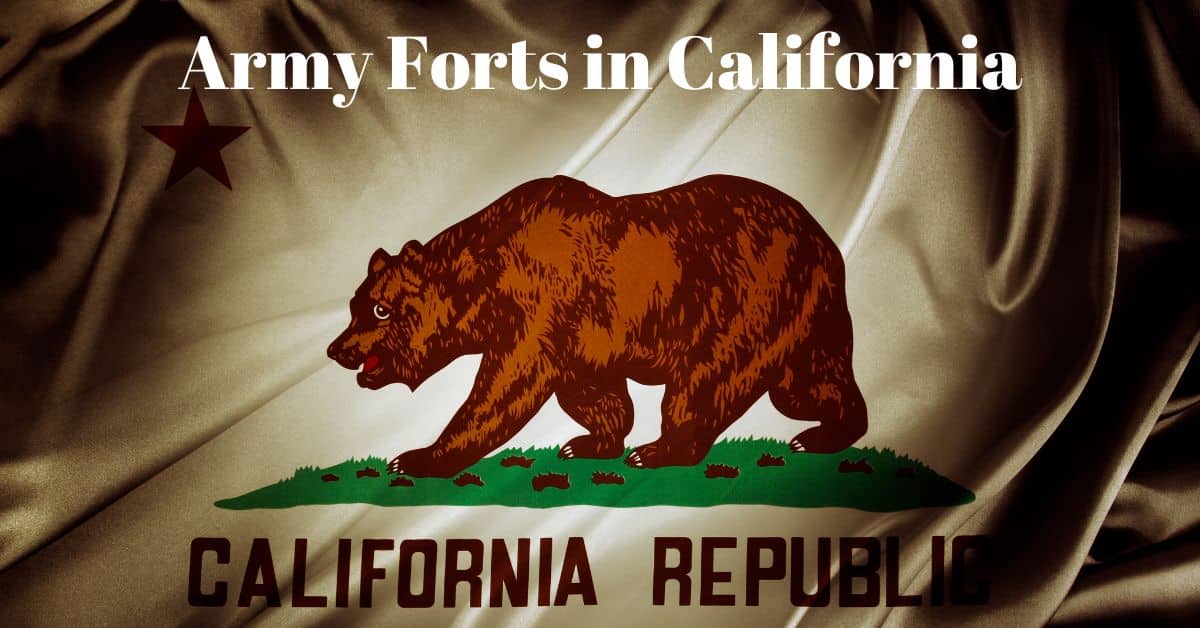California has a rich history dating back to the early days of the United States, and military forts have played a significant role in this history. These installations served as strategic points for various purposes, such as defense, communication, trade, and observation.
This article will explore some of California’s most important and interesting army forts, providing a glimpse into their fascinating pasts.
Army forts in California have been integral to the state’s development as they protected settlers during the westward expansion and securitized key transportation routes. Furthermore, these military bases have deeply influenced local and regional economies and serve as critical training and command centers for various military operations.
As we delve into the stories of these forts, the reader will understand their historical significance and continuing relevance in today’s world.
Historical Background of Army Forts in California

California has a rich history of army forts dating back to the early 19th century. These forts played a crucial role in the state’s development, providing protection and promoting trade during various periods of conflict and growth.
Both the Spanish and Mexican governments established the early forts in California. Some notable examples include the Presidio of San Francisco, established in 1776, and the Presidio of Santa Barbara, founded in 1782.
These presidios served as military and administrative centers, safeguarding the surrounding missions and settlements.
Important forts such as Fort Point and Fort Tejon were built during the Mexican-American War and the California Gold Rush. Fort Point, located beneath the iconic Golden Gate Bridge in San Francisco, was built in the 1850s to protect the entrance to the San Francisco Bay.
On the other hand, Fort Tejon was established in 1854 in southern California, offering protection to the settlers during the Indian Wars.
Additional forts and camps, including Camp Wright and Drum Barracks, were established during the Civil War. These largely focused on securing Union installations and supporting navy ships patrolling the Pacific Coast.
In the 20th century, California’s army forts expanded and evolved. World War II led to the development of numerous new bases and fortifications, such as Fort MacArthur and Camp Roberts.
These facilities played crucial roles in training soldiers and protecting the West Coast from potential attacks.
Many of these historic forts have been preserved and offer visitors insight into California’s military past. Some serve as museums, national parks, or state monuments, ensuring future generations can learn about their significance.
List of Notable Army Forts in California
California has a rich history of military forts, many of which played significant roles in the state’s development and national security. This section will discuss some of California’s most notable army forts.
Fort Point
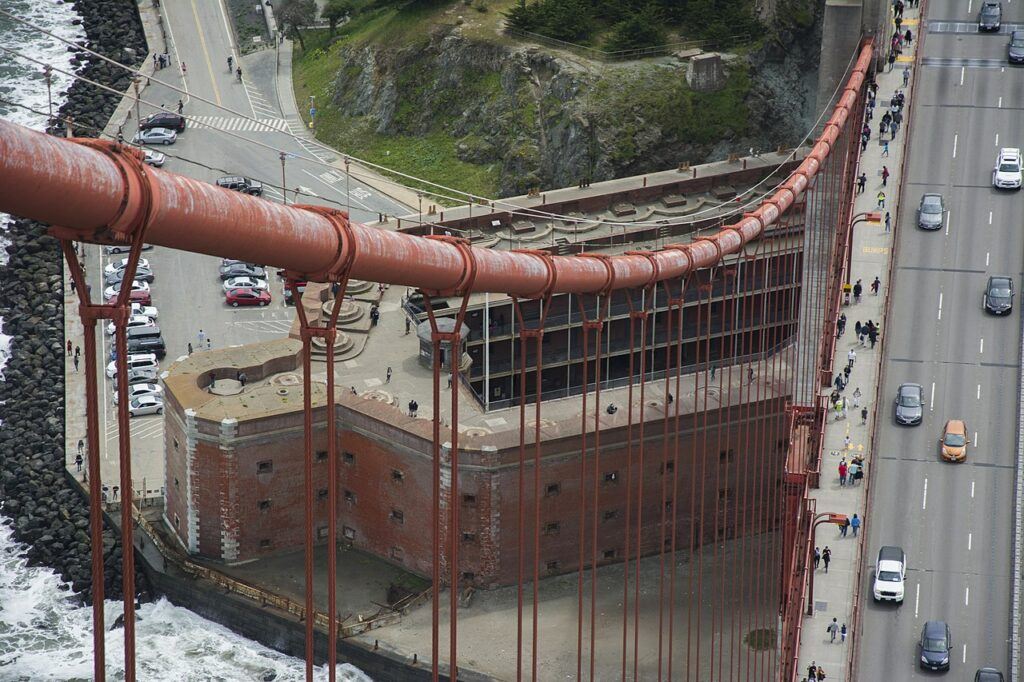
Fort Point is a historic seacoast fortification on the Golden Gate’s southern side at the San Francisco Bay entrance. It was built between 1853 and 1861 by US Army Engineers as a part of a defense system for the Bay Area after the California Gold Rush.
The fort was designed to defend the bay against hostile warships and was considered state-of-the-art. It was named after Brigadier General Joseph Warren Revere, a member of the engineering team that designed the fort.
Fort Point is a three-story brick and granite structure that stands 165 feet above sea level and covers an area of over 50,000 square feet. It was built in the shape of a pentagon and had three tiers of casemates: vaulted rooms that house cannons.
The fort also has historical landmarks like a barbette tier on the roof with additional guns and a sod covering to absorb the impact of enemy cannon fire.
The fort was armed with various guns, including 10-inch Rodman guns, which could fire a 128-pound shot over two miles. At its greatest strength, the fort mounted 102 cannons. This fort is on the National Register of Historic Places.
The Union Army never saw any real military action at Fort Point, but it played an important role in the history of the Bay Area. During the American Civil War, the fort showed the vulnerability of masonry forts to rifled cannons.
After the war, the fort was used as a training center for soldiers and artillery troops. In the early 20th century, the fort was used as a storage facility for military equipment.
Today, Fort Point is a National Historic Site open to the public for tours. Visitors can explore the fort’s beautifully arched casemates, which display the art of 3rd system brick masonry and interact gracefully with the Golden Gate Bridge.
Presidio of San Francisco
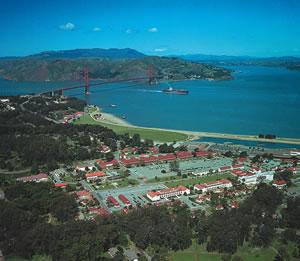
The Presidio of San Francisco is a historic military base located in the northern part of San Francisco. It was built by the Spanish in 1776 as a fort to protect the entrance to San Francisco Bay.
The Presidio has a rich history from the time of the native Ohlone people, the Spanish colonialists, Mexican rule, and finally, over 148 years of U.S. Army control. The Presidio became a preeminent military post under the U.S. Army before it became part of the Golden Gate National Recreation Area in 1994.
The Presidio is one of the nation’s largest and most innovative preservation projects, with 1,491 acres of forests, beaches, bluffs, hiking, biking trails, and 768 historic buildings and structures.
The area is home to some of the nation’s finest collections of fortifications, landscapes, buildings, structures, and artifacts related to military history. It also embraces the oldest national cemetery on the West Coast, the final resting place of many Medal of Honor awardees.
In addition to its rich history, the Presidio is a popular destination for locals and tourists alike. The area is home to several museums, including the Walt Disney Family Museum, the Presidio Officers’ Club, and the Museum of the African Diaspora.
Visitors can also enjoy outdoor activities such as hiking, biking, picnicking, and stunning Golden Gate Bridge and San Francisco Bay views. The Presidio is a unique and beautiful destination that offers a glimpse into the rich history of San Francisco and the United States.
Fort Tejon
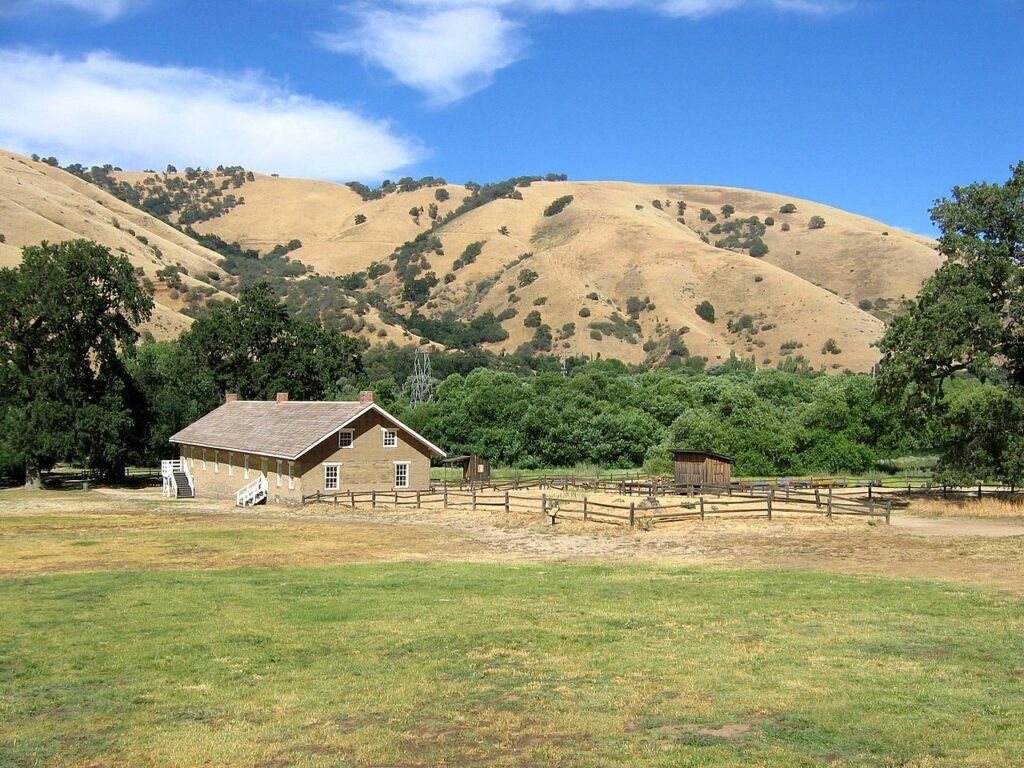
Fort Tejon is a former United States Army outpost in Grapevine Canyon, between the San Emigdio Mountains and Tehachapi Mountains in California.
It was established in 1854 by Edward Beale, Superintendent of California Indian Affairs, as a part of a system of forts to protect the settlers and travelers from Native American attacks. The fort was named after a nearby Tejon Indian village.
The US Army garrisoned Fort Tejon from 1854 to 1864, and it played an important role in the Indian Wars, the Civil War, and the Butterfield Overland Mail route protection. The fort was also used as a supply depot for the experimental U.S. Camel Corps in 1858, which used camels to carry supplies across the deserts of the American southwest.
The fort was abandoned in 1864 and fell into disrepair. In 1932, the fort was restored and became a California State Historic Park. Today, visitors can explore the restored adobes from the original fort and learn about army life and local history in the park’s museum.
The park also features beautiful 400-year-old Valley Oak trees and hosts several events throughout the year, including living history demonstrations, reenactments, and special exhibits.
Fort Tejon is a fascinating destination that offers a glimpse into the history of the American West. The fort played an important role in settlement of California and the protection of its inhabitants, and its restored buildings and exhibits provide a unique opportunity to learn about life in the 19th century.
Fort MacArthur
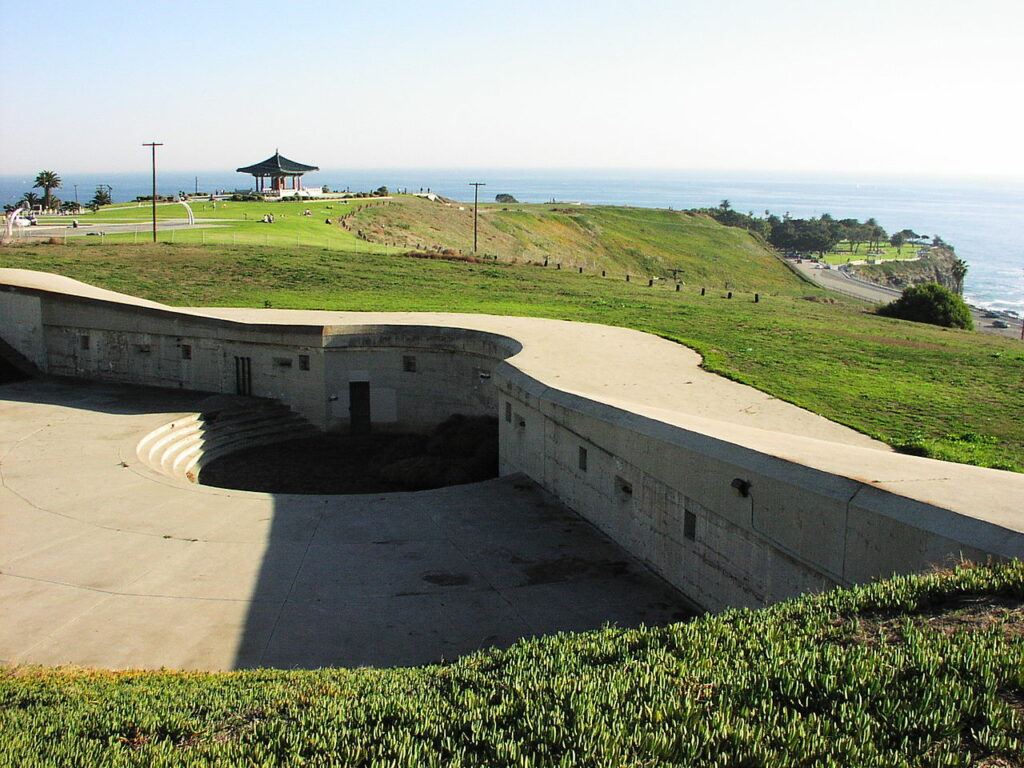
Fort MacArthur is a former United States Army installation in San Pedro, California. It was named after General Arthur MacArthur, Jr., the father of General Douglas MacArthur. The fort was established in 1914 as a coastal defense installation to protect the Los Angeles harbor from potential attacks by foreign naval forces.
During World War I and II, Fort MacArthur served as a training center for the US Army and was home to several artillery units. The fort was also used as a logistics center for transporting troops and supplies to the Pacific Theater during the war. After the war, the fort continued serving as a training center for the US Army until it decommissioned in 1974.
Today, Fort MacArthur is a historic site and museum that offers visitors a glimpse into the history of the American military. The museum features exhibits on the fort’s history, the role of the US Army in World War II, and the development of coastal defense systems.
Visitors can also explore the fort’s battery and gun emplacements, which have been preserved and restored to their original condition.
Fort MacArthur offers a glimpse into the history of the American military and its role in protecting the nation’s shores. The fort’s exhibits and restored battery and gun emplacements provide a unique opportunity to learn about the development of coastal defense systems and the role of the US Army in World War II.
More Forts: 21 Historic Forts of Tennessee
Strategic Importance of Army Forts in California
California’s army forts hold a significant position due to their strategic locations and historical roles. Many of these forts were established during the 19th and 20th centuries to protect and defend California’s rapidly growing population and economy.
Some of the key reasons for their importance include the following:
- Coastal Defense: Many forts were built along the coast to defend against potential enemy attacks and invasions. For example, Fort Point was constructed at the entrance of San Francisco harbor to safeguard the area from potential naval threats.
- Resource Protection: California’s gold rush attracted thousands of people, establishing forts like Fort Tejon and Fort Jones to protect valuable resources and maintain order during this chaotic time.
- Trade and Communication: Routes such as the Pacific Coast Highway and the Transcontinental Railroad were vital for trade and communication. Forts like Fort Humboldt and Fort MacArthur played critical roles in maintaining the security and functioning of these routes.
- Native American Relations: The forts also significantly managed interactions between European settlers and Native American tribes. Establishments like Fort Bidwell and Fort Crook helped maintain peace and resolve conflicts between these groups.
These forts provided security and resource management and served as prominent training and logistical centers for the U.S. military. Some forts were adapted and modernized as time passed to serve new roles and face modern threats. Fort Irwin, for instance, is now a major training facility for the United States Army that focuses on large-scale desert warfare.
Preservation and Tourism of California Forts
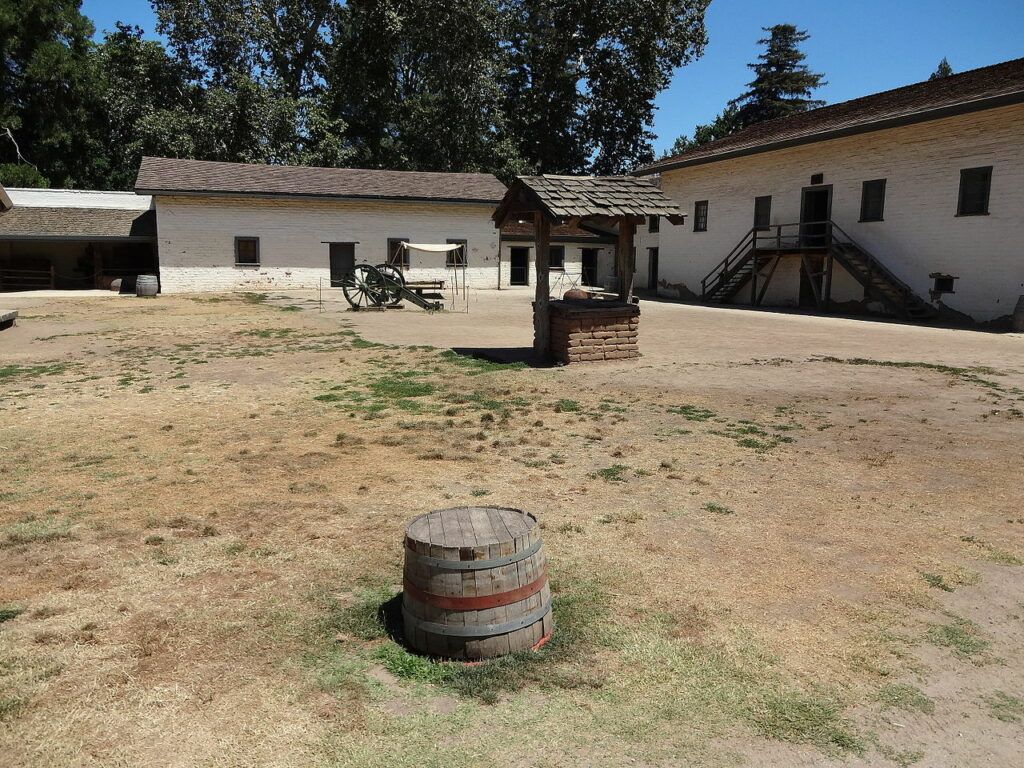
California’s army forts hold immense historical significance, making preservation and tourism essential for raising awareness and maintaining their rich heritage. Public and private organizations have undertaken concerted efforts to preserve these sites and promote tourism.
One example of such efforts is the restoration of Fort Point, located at the Presidio of San Francisco. The National Park Service has preserved the fort, transforming it into a popular tourist destination. Visitors can partake in educational programs, guided tours, and unique events held at the site.
Another notable site is Sutter’s Fort, in the heart of Sacramento. This California State Historical Park offers immersive experiences for tourists, such as living history days and hands-on workshops. These interactive events allow visitors to delve into California’s past and gain an appreciation for its military roots.
Tourism also benefits local communities, relying on the economic boost generated by visitors visiting these historical sites. This in turn, ensures ongoing preservation efforts:
- Increased revenue for local businesses and services
- Creation of job opportunities in the tourism and conservation sectors
- Incentives for additional funding and support for preservation projects
In conclusion, preserving California’s army forts and promoting tourism go hand in hand, contributing to their future upkeep and a deeper understanding of the Golden State’s intriguing military past.
Conclusion – Army Forts in California
In summary, the State of California has an important history of military forts contributing to its unique identity in the United States. These forts have served various purposes, such as defense structures, strategic points, and notable landmarks.
Exploring these forts today offers a fascinating insight into California’s role in American military history. Moreover, many of these sites have been repurposed or preserved, allowing visitors to experience the rich history firsthand.
Notable military installations to visit include :
- Fort Ross
- Fort Bragg
- Fort Humboldt
- Fort Point
- Fort McDowell
- Fort Hunter Liggett
- Presidio of Monterey in Monterey County
- Naval Base Coronado
- Vandenberg Air Force Base
- Naval Base Point Loma
These forts stand as a testament to the changing times and the significant role that California has played in the protection and prosperity of the United States throughout its history. California trains the Army National Guard at Camp San Luis Obispo. California also has Coast Guard Bases.

Cory is a website owner and content creator who enjoys fishing, history, coin collecting, and sports, among other hobbies. He is a husband and father of four.
Romans 15:4 For whatever was written in former days was written for our instruction, that through endurance and through the encouragement of the Scriptures we might have hope.

